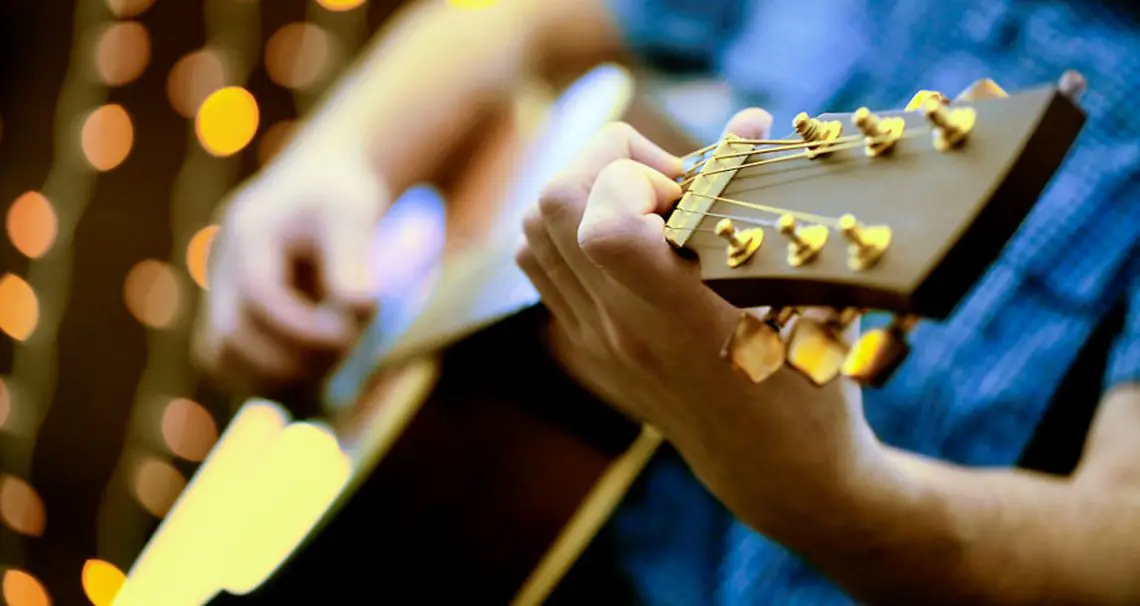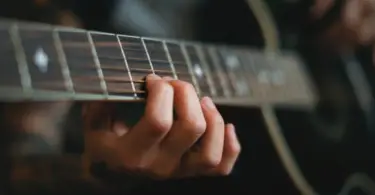If I were looking for a guitar that could deliver the most versatility and give me the best bang for my buck, I wouldn’t look any further than the Epiphone ES-339 PRO Semi-Hollow Electric Guitar. After the extensive research I conducted for this article, I would put it above dozens of others that each offer only a fraction of what the Epiphone ES-339 can.
Choosing the right guitar for you can be tough, however, especially considering that the “best” guitar for any player will depend largely on what style of music it will be used to play. While the other guitars we looked at couldn’t quite stand up, there are still plenty that made the honorable mentions.
-
 Check on Musician's Friend Check on eBay
Check on Musician's Friend Check on eBayOur top pick, the ES-339 has the best tone, playability, and appearance and is an excellent value.
-
-
-
-
-
 Check on Musician's Friend Check on eBay
Check on Musician's Friend Check on eBayA guitar that makes the transition to electric much easier.
-
 Check on Musician's Friend Check on eBay
Check on Musician's Friend Check on eBayPerfect for hitting those smooth, mellow notes when playing jazz guitar.
-
-
-
-
 Check on Musician's Friend Check on eBay
Check on Musician's Friend Check on eBayUnique design with their multiple sound holes built into the cutaway section of the body.
During our research, we looked closely at nearly 50 different guitars, not discriminating based on brand, and held each of them up close for inspection. We want to make sure that our recommendation is a well-informed one, and that it brings real value to you, the reader.
Along with our extensive research, I consider myself something of an expert on guitars. I started out playing electric bass in middle school, switched to a six string, and now have a decent collection of both electric and acoustic guitars. The past ten years of playing and owning guitars gives me some authority on the subject, for what it’s worth. I’m a fan of collecting guitars, and am always looking for the next one to add to my collection.
My Top Recommendation: The Epiphone ES-339 Semi-Hollow Body Electric Guitar
Our top pick, the ES-339 has the best tone, playability, and appearance and is an excellent value.
The Epiphone ES-339 Semi-Hollow Electric Guitar is the best 6-string guitar you can buy, and when stacked up against our qualifiers from earlier, it’s easy to see why. The ES-339 is a semi-hollow body electric guitar, which means that it is strung like an electric, plays like an electric, but has a solid block of wood that runs down the neck to the base, and two of those f-holes we mentioned earlier cut into the sides.

Credit: Epiphone
Sound
The Epiphone ES-339, like most semi-hollow bodies, has a warm tone, and due to its two humbuckers, is capable of a surprising amount of versatility while eliminating any unwanted feedback.
The semi-hollow design allows you to play it plugged in or by itself, and still delivers a great tone that can vary to warm and mellow, to bright and punchy. It even features a Push-Pull coil tapping, which allows for switching between the humbuckers and single coil tones for each pickup.
Playability
The Epiphone ES-339 features a slim taper “D” neck for both fast action and comfort while playing. I myself, while I don’t own it, have found that the action is better than my Ibanez hollow body, but not quite as good as my solid body electric. Still, it hits that sweet spot for me, and I’d trade my hollow body for it in a heartbeat.
Appearance
I know I said it doesn’t matter as much earlier, but when it works along with everything else, it really works. The ES-339 has a body with a double-cutaway, which gives it a sleek look. The size, while bigger than most solid bodies, is till smaller than hollow bodies or acoustics, and rests comfortably (at least it did for me) under the crook of my arm.
Price
The price of the Epiphone ES-339 may go above the pay grade of any beginner players, but for the more experienced and seasoned guitarists, the price hits the middle of the road pretty squarely. This guitar won’t quite break the bank, and in my honest opinion is a steal for all it offers.
All things considered, it’s not hard to see why the Epiphone ES-339 semi-hollow body electric guitar hits the top of our list. It looks great, plays easy, and remains one of the more versatile options on the market today.
Runner Up: The Fender Standard Stratocaster
When looking to choose the best 6-string guitar, it’s hard to keep this classic choice from any list. The Fender Stratocaster has a long history of reliability, and has been the number one choice for guitarists such as Jimi Hendrix and Pink Floyd’s David Gilmour. Along with that, if you’re going for a specific tone, there are few guitars that can mimic the sound achieved by the Stratocaster’s three single coil pickups.
As far as this list is concerned, however, the Stratocaster is lacking in a one or two areas. As far as electric guitars go, it remains the most versatile, but without the semi-hollow body like the Epiphone ES-339, it can’t quite reach the same mellow tones that are desirable when playing styles of music like jazz.
Along with that, the Stratocaster is a bit pricey when compared to other guitars on the market. Coming in at six hundred dollars, this guitar is recommended for the more experienced player who knows what they’re getting and what they want.
Other 6-String Guitars for Beginners to Consider
Below we’ve taken the liberty of laying out a few more options to consider when purchasing a guitar. These options vary in range of price, and include solid body electrics, semi and hollow body electrics, acoustics, and acoustic electric guitars.
Epiphone SG-Special Electric Guitar
A good, solid body electric guitar that is ideal for beginners who want to stick with electric guitar, the Epiphone SG features a similar look to the red Gibson SG played by AC/DC’s Angus Young. the pickups on it work extremely well, and the price can’t be beaten for an entry-level guitar, at less than two hundred dollars.

Credit: Epiphone
The only cons you’ll see may be in the quality of its construction, as the volume and knobs are likely to wear out faster than more expensive models. You can find it here.
Washburn Oscar Schmidt OE30 Semi-Hollow
Good semi-hollow body guitar that won't break the bank.
Another good semi-hollow body guitar that won’t break the bank. If you like the Epiphone ES-339, but can’t quite afford it, this would be the next best semi-hollow electric that I’d recommend you pick up.

Credit: Oscar Schmidt
At just over two hundred dollars, however, you may run into construction problems like with the Epiphone SG. It’s always a bit more of a risk when going for a cheaper product, but the tone you can get with the Washburn Oscar Schmidt OE30 delivers well above its price range. You can find it here.
Epiphone Les Paul-100 Electric Guitar
Great entry-level guitar for beginners.
I know, I know, another Epiphone? Hey, they’re a solid brand, and they make great entry-level guitars, what can I say? If you want to go ahead and check out the Gibson version, I promise it will cost more than you’d like it to, while the Epiphone Les Paul comes in at just under five hundred dollars at time of review.

Credit: Epiphones
This hits the sweet spot in price for the serious starter guitar, but even if you only want a good solid body electric, you won’t be disappointed.
Squier by Fender Deluxe Hot Rails Stratocaster Electric Guitar
A guitar that makes the transition to electric much easier.
And, for those who want to stick with that unique Fender Strat tone, but don’t want to fork up six hundred bucks, the Squire series by Fender is a good, affordable option that never disappoints. You’ll find that the Squire Stratocaster lives up to the full Fender name in all but the little things.
Some precision on the quality of its construction, and a tremolo bar that isn’t quite full size to name a few. Still, at half the price of the full Fender version, at some point you have to wonder how much you’re paying for just the name. You can find the Squire Strat here.
Ibanez Artcore AF75 Hollow-Body Electric Guitar
Perfect for hitting those smooth, mellow notes when playing jazz guitar.
Now I had to add this beauty, because as I write this one is sitting on its stand in the corner of my room. I love this hollow body electric, and it’s perfect for hitting those smooth, mellow notes when playing jazz guitar.

Credit: Ibanez guitars
The only downsides to the Ibanez Artcore AF75 are that your tone is more susceptible to feedback, and the floating bridge it comes equipped with can make changing the strings a pain at times, and can also mess with the tuning.
All in all, it’s still a solid choice, and can even be played unplugged comparable to an acoustic. You can check it out here for purchase at a reasonable four hundred dollars.
Epiphone Hummingbird PRO Solid Top Acoustic/Electric Guitar
Soft, acoustic style of fingerpicking.
Now on to the acoustic guitars. If you’re looking for that soft, acoustic style of fingerpicking, you couldn’t pick a better option than the Hummingbird PRO by Epiphone.

Credit: Epiphone
While it may at first look like one of those guitars where you’re only getting a certain kind of appearance, the Hummingbird PRO delivers in terms of both tone and playability, and if you can afford the three hundred dollar price tag, it is sure to be a guitar that you will never outgrow.
Taylor GS Mini Mahogany GS Mini Acoustic Guitar
Good option for guitarists with smaller hands or frame.
For guitarists with a larger budget looking to buy a solid acoustic guitar with a comfortable, smaller body, the Taylor GS Mini is a great choice. This can be a good option for guitarists with smaller hands or frame, as the neck is not as wide as a standard-sized guitar, and you won’t have to reach your hands around as much of a body.

Credit: TAYLOR-LISTUG, INC
As long as you’re okay with the smaller body and reduced volume compared to full-size guitars, then the Taylor GS Mini is the one for you. You can find it here.
Yamaha A-Series AC1M Small-Body Acoustic-Electric Guitar
Another affordable option for an acoustic-electric guitar, the Yamaha AC1M is also blessed with a smaller size for those more petite players out there. While it is a little more expensive than the Hummingbird PRO, the Yamaha AC1M comes with a pickup and built-in tuner to ensure that you’re always hitting the right notes.
Along with that, you’ll notice no difference in tone once you plug it in, although one downside is that its action is less forgiving for sloppy playing, so make sure you hit those notes perfectly, and you’ll be fine. You can find it here.
Ovation Celebrity Elite CE44-5 Acoustic Electric Guitar
Unique design with their multiple sound holes built into the cutaway section of the body.
Perhaps a less well-known brand, but Ovation guitars feature a unique design with their multiple sound holes built into the cutaway section of the body. The Ovation CE44-5 offers a smooth and fast action, and its ten inch in radius neck helps to make this guitar even more playable.

Credit: Amazon.com
At a price of under five hundred dollars, this acoustic-electric beauty delivers a unique tone with clear highs and a balanced bass but will sound different than a guitar with a more standard design. For the adventurous and fun-loving player, you can find the Ovation CE44-5 here.
How to Choose Your 6-String as a Beginner
It’s important to know what things to consider before going out and throwing down a few hundred bucks on some guitar just because you read a good review of it. With that being said, we’ve outlined below the specific things you should consider that will lead you to the perfect purchase for you.
Style
Style is possibly one of the most important things you should be sure of before picking a guitar. What kind of music do you like? When you picture yourself playing guitar, are you on a stage rocking out to thrash-metal, or in a field of dandelions plucking a finger style melody to a beautiful boy or girl?
You want to know this first, and it usually boils down to a choice between acoustic or electric. If I could tell you to just pull the trigger and buy one of each, I would.
Acoustic Guitars
Acoustic guitars are great choices for beginners who want to eventually play electric, but for some reason may feel intimidated by it at first. Many guitar teachers will recommend you start out by playing an acoustic so that you can get a good feel for the tone and touch of playing.
It can be a little hard at first, as acoustic strings tend to be thicker and harder to press down on the frets, but the rewards can be great. Once you have been practicing on an acoustic for years and switch to an electric, your fingers will feel like they are sliding over the frets. From there, speed is much easier to achieve.
Classical Guitars (Nylon Strings)
An alternative option for the beginner who doesn’t want to go through the pain of developing calluses on an acoustic, classical guitars are always a good option. They can give the same valuable experience of developing touch and control, and they’ll save your fingers from bleeding. For the purposes of this post, however, we have left out any nylon stringed guitars, and are sticking with acoustic and electric.
Electric Guitars
This is probably what most people think of when they think of guitars. Images of Jimi Hendrix playing one with his teeth, or Brian May tearing through a technical and soulful solo come to my mind, but yours may be different.
Electric guitars have a huge advantage of being able to manipulate and amplify their sound through the use of amplifiers and effects pedals, which can make such significant changes that it may not even be recognized as a guitar.
Along with this, electric guitars are far easier to play. The strings only need to vibrate enough to send a sound to the pickups and then to the amp, so there’s no need for the fatter strings of an acoustic, which are made to resonate more. I still wouldn’t recommend an electric for a first guitar, because if you ever decide to pick up an acoustic you will find it harder to press down on the strings, which can be embarrassing.
There are of course the gray areas of acoustic-electric guitars, as well as semi and hollow-bodied electrics. You can think of acoustic -electrics just as you would an acoustic, and semi-hollow and hollow-bodied electrics as electrics for now. We’ll get to them in due time.
What to Look at Before Purchasing
Now that we’ve covered some of the basics, let’s take a look at what specific elements you’ll want to look at before choosing the right guitar for you. While these can vary, most beginners will look at things like price, sound, and appearance. While these can all be significant, we’re going to widen our scope here to include the action and playability.
What Do We Mean by “Action”?
For those who haven’t heard this term before, action is used to describe the distance between the strings and the frets. Too high of an action can make the strings hard to press down and reach the frets, while too low of one will cause a displeasurable buzzing to occur when the strings hit the higher frets.
This is why picking up a guitar and playing it yourself is the best method for getting that Goldilocks level of action, not too high and not too low.
Playability
Playability is linked closely with action, as it is one of the factors that goes into determining how playable a guitar is. This can be a commonly overlooked category for the beginner, which can lead to some unfortunate results if they end up having difficulty learning their instrument due to playability.
They may think that it has to do with their ability instead of a poorly-made guitar. Other factors that can determine playability are the strings, the length of the neck, and the size of the guitar.
Sound (or “Tone”)
One of the most important categories to get right when purchasing a guitar, the tone is everything. What does it matter if you have the coolest-looking guitar if every note you play sounds tinny and thin? You’ll have a much harder time getting anyone to listen to you play, and isn’t that at least what this is all (kind of) about?
This is another reason why playing a guitar before you buy it is always a good choice. You want to know what it actually sounds like before dropping any money. What’s most important when considering tone is to go with a sound that you personally like. It may not be everyone’s cup of tea, but if it works for you, go for it.
Price
Definitely something that will factor into your decision whether you want it to or not. We all only have so much money to spend on our passions, and this amount will vary from person to person.
For those just starting out, I’d recommend not pushing past the $400 mark. At that level, you’re sure to get a decent guitar, and more importantly, you’ll be able to shoot toward a goal of a nicer one once you’ve put in more practice time. When making our decision we tried to hit a good middle-of-the-road guitar priced for players of all levels, but for true beginners, I’d still recommend one of the honorable mentions listed at the end of the article.
Appearance
Arguably the least important factor when purchasing a guitar, in my opinion, but still one to consider if you want your guitar to reflect your style. When looking at appearance though, try to consider the benefits of certain design choices, and how they might affect playability too.
Does a guitar have enough of a cut-away for you to reach those higher notes? Do you just like how the f-holes look on a hollow body, or will it actually give you the tone you want when you plug it in? We all want pretty guitars, just don’t sacrifice appearance for playability.
Here’s a recap of the 6-string guitars we covered:
Our top pick, the ES-339 has the best tone, playability, and appearance and is an excellent value.
Good semi-hollow body guitar that won't break the bank.
Great entry-level guitar for beginners.
A guitar that makes the transition to electric much easier.
Perfect for hitting those smooth, mellow notes when playing jazz guitar.
Soft, acoustic style of fingerpicking.
Good option for guitarists with smaller hands or frame.
Unique design with their multiple sound holes built into the cutaway section of the body.


















Start the discussion at talk.hearthemusicplay.com